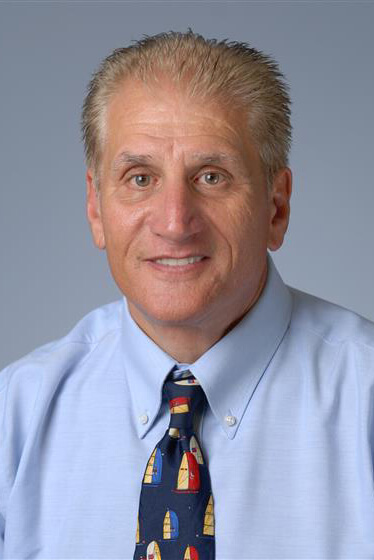
Louis M. Pelus, PhD
Professor Emeritus of Microbiology & Immunology
- Phone
- (317) 274-7565
- Address
-
R2 302
MCIM
IN
Indianapolis, IN 46202 - PubMed:
-

Bio
Louis Pelus, PhD, joined IU School of Medicine in 1999. The recipient of multiple research grants, Dr. Pelus' areas of research focuses on understanding production and regulation of the stem cells that form the cellular elements of blood and how these regulatory pathways can be leveraged for therapeutic benefit.
Key Publications
Rapid Mobilization Reveals a Highly Engraftable Hematopoietic Stem Cell.
Hoggatt J, Singh P, Tate TA, Chou BK, Datari SR, Fukuda S, Liu L, Kharchenko PV, Schajnovitz A, Baryawno N, Mercier FE, Boyer J, Gardner J, Morrow DM, Scadden DT, Pelus LM.
Cell. 2017 Nov 17. pii: S0092-8674(17)31312-0. doi: 10.1016/j.cell.2017.11.003. [Epub ahead of print]
PMI
Neuropeptide Y regulates a vascular gateway for hematopoietic stem and progenitor cells.
Singh P, Hoggatt J, Kamocka MM, Mohammad KS, Saunders MR, Li H, Speth J, Carlesso N, Guise TA, Pelus LM.
J Clin Invest. 2017 Nov 13. pii: 94687. doi: 10.1172/JCI94687. [Epub ahead of print
| Year | Degree | Institution |
|---|---|---|
| 1977 | PhD | Rutgers University |
| 1973 | BA | Queens College |
Dr. Pelus' laboratory is interested in the mechanisms that control blood cell proliferation, differentiation and migration, and how these pathways can be leveraged to define new therapies for leukemia and cancer. The primary focus of the laboratory is to understand the mechanisms that control hematopoiesis, the process by which blood cells are produced, and the disordered regulation of cell proliferation and survival characteristic of cancer cells. These studies are progressing at the molecular, cellular and animal level.
In the hematopoietic system, marrow stem cells can be forced to migrate to peripheral blood where they can be collected and used for transplantation, a curative therapy for many cancers. The laboratory has identified GRO beta , a member of a family of peptides called chemokines, which stimulates the migration of stem cells that are able to completely reconstitute hematopoiesis from bone marrow to blood. Chemokine "mobilized" stem cells restore blood formation more rapidly than cells mobilized by hematopoietic growth factors such as G-CSF. The chemokine GRO beta specifically interacts with the CXCR2 chemokine receptor on blood neutrophils releasing matrix metalloproteinases that we believe are responsible for the "release" of cells from bone marrow. Studies are currently underway to determine the differences between GRO beta and G-CSF mobilized stem cells, the intracellular and extracellular events initiated by GRO beta -CXCR2 interaction that leads to migration of stem cells and how this is regulated, and how combination therapy with other cytokines, chemokines and their receptors can define new paradigms for stem cell transplantation. The answer to these questions will benefit patients receiving extensive chemotherapy who require hematopoietic support or who could benefit from curative hematopoietic stem cell transplantation.
The role(s) of the bioactive lipid Prostaglandin E2 (PGE) in hematopoiesis is another major focus of the Pelus laboratory. The group has found that PGE can modulate many aspects of blood cell production and function. It can be used to enhance stem cell trafficking to bone marrow, enhance gene therapy, protect and mitagate the effects of lethal irradiation and in some cases reverse aging effects on blood stem cells. All these areas are currently being evalauted mechanistically.
Dr. Pelus has also found that inhibiting the enzyme that produces PGE using aspirin molecules, can engance collection of blood stem cells for transplantation. A clinical trial is currently underway to enhance stem cell collection in patients with cancer undergoing autologous bone marrow transplantation, and gene sequencing of the stem cells mobilized with the help of aspirin like molecules is underway.
Patterson AM; Orschell CM; Pelus LM; Methods in molecular biology (Clifton, N.J.) 2023
Patterson AM; Vemula S; Plett PA; Sampson CH; Chua HL; Fisher A; Wu T; Sellamuthu R; Feng H; Katz BP; DesRosiers CM; Pelus LM; Cox GN; MacVittie TJ; Orschell CM; Radiation research 2022 Sep 1
Fukuda S; Matsuda N; Shoji T; Onishi C; Hirade T; Taketani T; Pelus LM; Leukemia research 2022 Oct 29
Liu L; Li H; Patterson AM; Plett PA; Sampson CH; Mohammad KS; Capitano ML; Singh P; Yao C; Orschell CM; Pelus LM; Stem cell reviews and reports 2022 Mar 23
Patterson AM; Zhang S; Liu L; Li H; Singh P; Liu Y; Farag SS; Pelus LM; Stem cell reviews and reports 2021 Sep 12
Patterson AM; Plett PA; Sampson CH; Simpson E; Liu Y; Pelus LM; Orschell CM; Stem cell reviews and reports 2021 May 11
Patterson AM; Wu T; Chua HL; Sampson CH; Fisher A; Singh P; Guise TA; Feng H; Muldoon J; Wright L; Plett PA; Pelus LM; Orschell CM; Radiation research 2021 Feb 1
Singh P; Mohammad KS; Pelus LM; Stem cells (Dayton, Ohio) 2020 Mar 11
Patterson AM; Liu L; Sampson CH; Plett PA; Li H; Singh P; Mohammad KS; Hoggatt J; Capitano ML; Orschell CM; Pelus LM; Stem cell reports 2020 Jul 30
Singh P; Kacena MA; Orschell CM; Pelus LM; Stem cell reviews and reports 2020 Aug
Maupin KA; Himes ER; Plett AP; Chua HL; Singh P; Ghosh J; Mohamad SF; Abeysekera I; Fisher A; Sampson C; Hong JM; Childress P; Alvarez M; Srour EF; Bruzzaniti A; Pelus LM; Orschell CM; Kacena MA; Bone 2019 Jul 9
Hoggatt J; Singh P; Tate TA; Chou BK; Datari SR; Fukuda S; Liu L; Kharchenko PV; Schajnovitz A; Baryawno N; Mercier FE; Boyer J; Gardner J; Morrow DM; Scadden DT; Pelus LM; Cell 2017 Nov 17
Singh P; Hoggatt J; Kamocka MM; Mohammad KS; Saunders MR; Li H; Speth J; Carlesso N; Guise TA; Pelus LM; The Journal of clinical investigation 2017 Nov 13